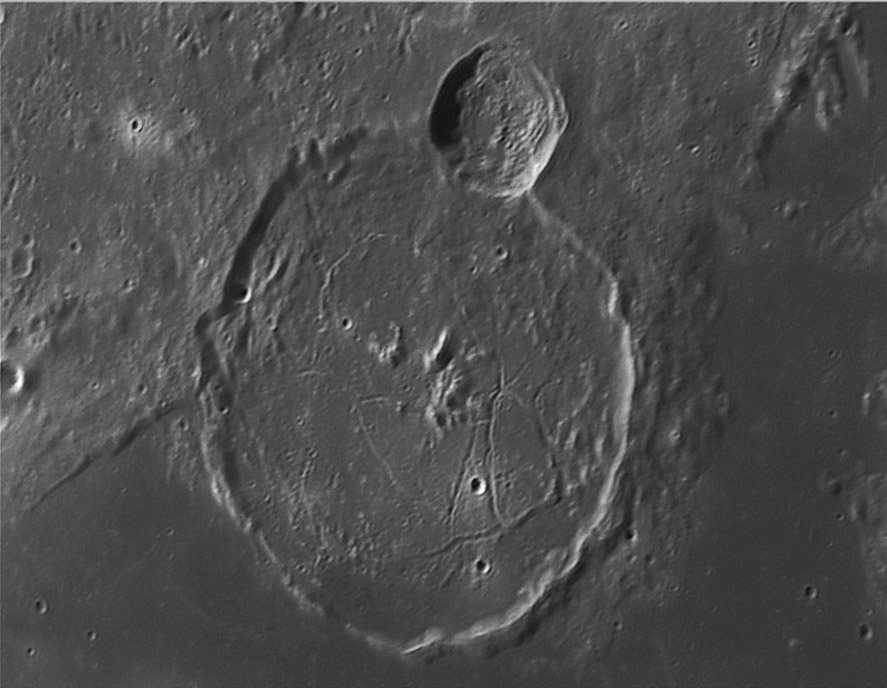Difference between revisions of "September 22, 2012"
(Replaced content with "__NOTOC__ =Cutting Comments= <!-- Start of content --> {{wiki/ArticleFooter}}") |
|||
| Line 2: | Line 2: | ||
=Cutting Comments= | =Cutting Comments= | ||
<!-- Start of content --> | <!-- Start of content --> | ||
| + | <!-- ws:start:WikiTextHeadingRule:0:<h1> --> | ||
| + | <!-- ws:start:WikiTextLocalImageRule:6:<img src="/file/view/LPOD-Sep22-12.jpg/366813664/LPOD-Sep22-12.jpg" alt="" title="" /> -->[[File:LPOD-Sep22-12.jpg|LPOD-Sep22-12.jpg]]<!-- ws:end:WikiTextLocalImageRule:6 --><br /> | ||
| + | <em>image by [mailto:raffaele.barzacchi@gmail.com Raffaele Barzacchi]</em><br /> | ||
| + | <br /> | ||
| + | The rilles in Gassendi are not equally prominent. The ones on the right in Raf's image are deeper, sharper-edged, wider and more linear than the rilles along the bottom and on the left. Only one rille at upper left seems as sharp. The rilles on the right cut material that is smooth textured and light hued. If it is volcanic it isn't the same iron-rich lavas as the dark maria. The terrain on the left is rubbly and a wide swath of hilly material arcs across the top and left, and a ring of hills is along the bottom right. Does the difference in terrain cause the differences in the rilles? For example, it is possible that the smooth terrain is stronger so that when a rille forms it is sharply defined because its edges don't crumble. Or the right side rilles might be sharper just because they are younger. What evidence do you see that might explain the differences?<br /> | ||
| + | <br /> | ||
| + | <em>[mailto:tychocrater@yahoo.com Chuck Wood]</em><br /> | ||
| + | <br /> | ||
| + | <strong>Technical Details</strong><br /> | ||
| + | Sept 3, 2010, 01:31 UT. C14XLT, f/20, R+IR filter, PRG CCD@20 fps, res 90%.<br /> | ||
| + | <br /> | ||
| + | <strong>Related Links</strong><br /> | ||
| + | Rükl plate [http://the-moon.wikispaces.com/R%C3%BCkl+52 52]<br /> | ||
| + | <br /> | ||
| + | <hr /> | ||
| + | <!-- ws:start:WikiTextHeadingRule:2:<h3> --><h3 id="toc1"><!-- ws:end:WikiTextHeadingRule:2 -->COMMENTS?</h3> | ||
| + | Click on this icon <!-- ws:start:WikiTextLocalImageRule:7:<img src="/file/view/PostIcon.jpg/293056078/PostIcon.jpg" alt="" title="" /> -->[[File:PostIcon.jpg|PostIcon.jpg]]<!-- ws:end:WikiTextLocalImageRule:7 --> at the upper right to post a comment.<br /> | ||
| + | <br /> | ||
| + | <!-- Removed reference to store page --> | ||
| + | <p><b>Yesterday's LPOD:</b> [[September 21, 2012|Coming Out]] </p> | ||
| + | <p><b>Tomorrow's LPOD:</b> [[September 23, 2012|Three Easy Pieces]] </p> | ||
| + | <!-- End of content --> | ||
{{wiki/ArticleFooter}} | {{wiki/ArticleFooter}} | ||
Revision as of 17:00, 8 February 2015
Cutting Comments

image by Raffaele Barzacchi
The rilles in Gassendi are not equally prominent. The ones on the right in Raf's image are deeper, sharper-edged, wider and more linear than the rilles along the bottom and on the left. Only one rille at upper left seems as sharp. The rilles on the right cut material that is smooth textured and light hued. If it is volcanic it isn't the same iron-rich lavas as the dark maria. The terrain on the left is rubbly and a wide swath of hilly material arcs across the top and left, and a ring of hills is along the bottom right. Does the difference in terrain cause the differences in the rilles? For example, it is possible that the smooth terrain is stronger so that when a rille forms it is sharply defined because its edges don't crumble. Or the right side rilles might be sharper just because they are younger. What evidence do you see that might explain the differences?
Chuck Wood
Technical Details
Sept 3, 2010, 01:31 UT. C14XLT, f/20, R+IR filter, PRG CCD@20 fps, res 90%.
Related Links
Rükl plate 52
COMMENTS?
Click on this icon PostIcon.jpg at the upper right to post a comment.
Yesterday's LPOD: Coming Out
Tomorrow's LPOD: Three Easy Pieces
COMMENTS?
Register, Log in, and join in the comments.



